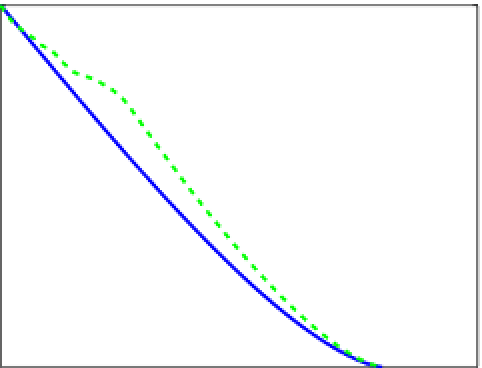Biomedical Engineering Reference
In-Depth Information
through multiplication. To empirically measure
the overall MTF of an optical system, sinusoidal
patterns of various spatial frequencies could be
imaged, and the value of
m
could be determined
for each of those frequencies. This piecewise
data could be used to estimate the MTF. If
desired, an inverse Fourier transform of this
empirically derived MTF could then be used to
estimate the overall PSF of the optical system.
Note that optical imaging systems are often
specified in terms of units such as l p/mm,
which stands for
line pairs per millimeter
, instead
of specifying some maximum frequency sinu-
soidal pattern that can be detected. A
line pair
is
a white stripe and black stripe, and it is a far
easier pattern to produce than an accurate sinu-
soidal pattern. However, a line-pair pattern is
not sinusoidal, so measurements using this pat-
tern do not directly yield the MTF; instead, they
yield something called the
contrast transfer func-
tion
(CTF). But a line-pair pattern is to a sinusoi-
dal pattern as a square wave is to a sine wave,
so the conversion between CTF and MTF is well
known
[24]
. Shown in one dimension
7
for com-
pactness, the relationship is
1
OTF
CTF
0.8
0.6
0.4
0.2
0
0
0.5
1
Normalized spatial frequency
FIGURE 1.9
Comparison of an MTF with a CTF of a cir-
cular aperture.
methods, such as the use of laser speckle patterns
[25], have been developed for empirically obtain-
ing the MTF of optics and detector arrays
[25]
.
1.2.2.3 Aberrations
When the optics include significant aberra-
tions, the PSF and OTF can be complex-valued
and asymmetrical. In general, aberrations will
broaden the PSF and consequently narrow the
OTF. An excellent treatment of these effects can
be found in Smith
[8]
. Aberrations can reduce the
cutoff frequency, cause contrast reversals, cause
zero-contrast bands to appear below the cutoff
frequency, and generally reduce image qual-
ity. A proposed quantitative measure of aber-
rated image quality is the
Strehl ratio
, which is
the ratio of the volume integral of the aberrated
two-dimensional MTF to the volume integral of
the associated diffraction-limited MTF
[8]
. In dis-
cussing aberrations, it is important to recall from
earlier that optical components that are not sepa-
rated by a diffuser of some sort may compensate
for the aberrations of each other—hence the term
=
π
4
C
(
u
) +
C
(
3
u
)
3
−
C
(
5
u
)
5
+
C
(
7
u
)
7
M
(
u
)
+
C
(
11
u
)
11
−
C
(
13
u
)
13
(1.7)
···
where
M
(
u
)
is the MTF and
C
(
u
)
is the CTF at
spatial frequency
u
. Note that the existence and
sign of the odd harmonic terms are irregular; see
Coltman
[24]
for details. While the relationship
is an infinite series, using just the six terms
explicitly shown in Eq.
(1.7)
will usually provide
sufficient fidelity.
Figure 1.9
compares the normalized MTF to
the normalized CTF, due only to a circular aper-
ture. Note that the CTF tends to overestimate the
image contrast compared to the true MTF. Other
7
To simplify the discussion at some points, we assume that two-dimensional functions are separable in Carte-
sian coordinates. This is not exactly true, but the errors caused by this assumption are typically very small
[15]
.













